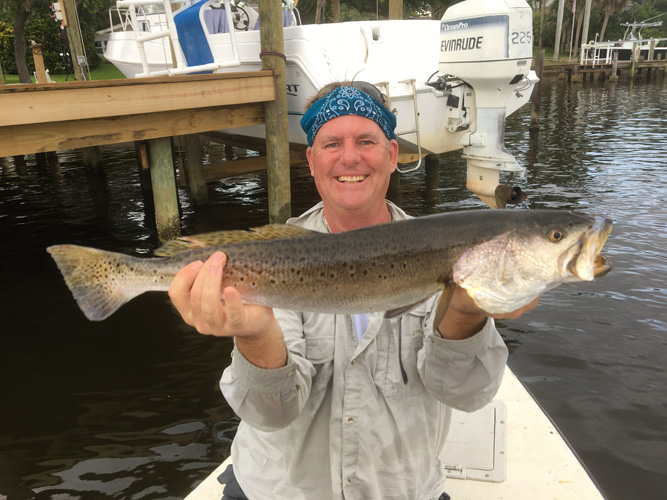More spotted sea trout than ever before have been recorded reproducing in the Indian River Lagoon between Vero Beach and Fort Pierce, a highly encouraging indicator of good water quality in our stretch of the 150-mile-plus estuary.
That’s the gist of a just-completed scientific study by prominent Vero marine scientist Dr. Grant Gilmore – a former Harbor Branch researcher and founder of Estuarine Coastal and Ocean Science – and a cadre of local fisherman-volunteers using underwater sound technology.
The findings are important because sea trout – a major recreational and commercial fishery all along the lagoon – are regarded as a ‘canary in the coal mine’ for water quality. The fish need clear, clean water that is more salty than fresh to thrive and reproduce.
For that reason, their presence and spawning activity is a marker for good water quality in the lagoon, while the absence of spawning trout indicates polluted or otherwise out of whack parts of the estuary, where there is too much fresh water and too little seagrass.
“Down here, we had trout spawning everywhere we checked,” Gilmore said, referring to lagoon waters between Oslo Road in Vero Beach and Harbor Branch Oceanographic Institute in Fort Pierce.
“From Indian River County down to Fort Pierce, it’s good as gold,” Gilmore said of trout spawning activity. “The Fort Pierce Inlet keeps the lagoon alive with seagrass and trout … the water quality is mediated by Fort Pierce Inlet tidal flow.”
But the news was not so good in Brevard County to our north, where there’s little trout spawning going on in portions of the Banana River, and even worse to our south in Martin County.
“No trout spawning in Martin County, period. It’s the first time ever they completely disappeared. Brevard County is a mixed bag – trout still spawn, but the locations they used to spawn, they aren’t spawning anymore.”
Armed with a $25,000 grant and volunteer manpower from the recreational fishing and conservation group CCA-Florida, Gilmore arrived at his findings by using underwater microphones to eavesdrop on trout spawning in the north, central and southern portions of the lagoon on full and new moon nights from May through September.
Gilmore taught the volunteers how to distinguish the sounds of trout making whoopee from noises made by other spawning species such as toadfish and silver perch – “kind of like bird calls,” Gilmore said.
For example, when spawning trout really get into the swing of things, they emit sounds from vibrations in their gas bladders like the clickety-clacking of a freight train on a track.
The volunteers learned how to make underwater recordings, rated the intensity of the spawning activity on a scale from 1 to 3, and then submitted those reports to Gilmore.
Gilmore has been listening in on amorous trout and other species throughout the lagoon for about 40 years, so he has amassed plenty of data for comparison. He said his field studies match findings from research conducted in the lab that show trout require clear water at higher salinities in order to thrive.
Gilmore said the hydrophone studies should be continued throughout this summer’s spawning season and expanded to include the lagoon between the Wabasso Causeway and Sebastian Inlet, and from Sebastian Inlet north to Grant.
“To me, this project is extremely important,” he said. “Anglers need to do something about this and fight for clear water and fight for protecting spawning sites.”
Vero Beach fishing guide captain Paul Fafeita, who is president of the Treasure Coast chapter of CCA-Florida and of the newly formed Clean Water Coalition of Indian River County, says he intends to continue the spawning surveys and hopes to expand them.
Fafeita says he’s seeking a grant from the Florida Fish and Wildlife Conservation Commission (FWC) to implant female trout with acoustic tags to narrow down spawning locations. Whenever a trout swims near an underwater listening station, its tag pings the location. He also wants to work with the FWC to post informational signs to keep boaters away from sea grass beds.
“Trout are among the most sensitive fish in the lagoon,” Fafeita said.

